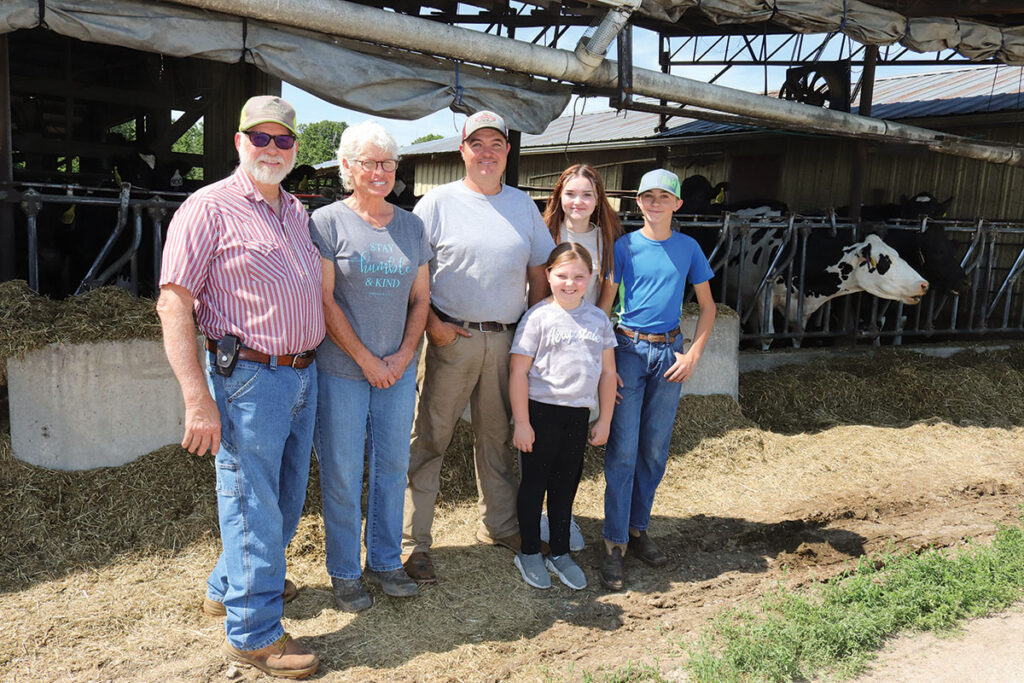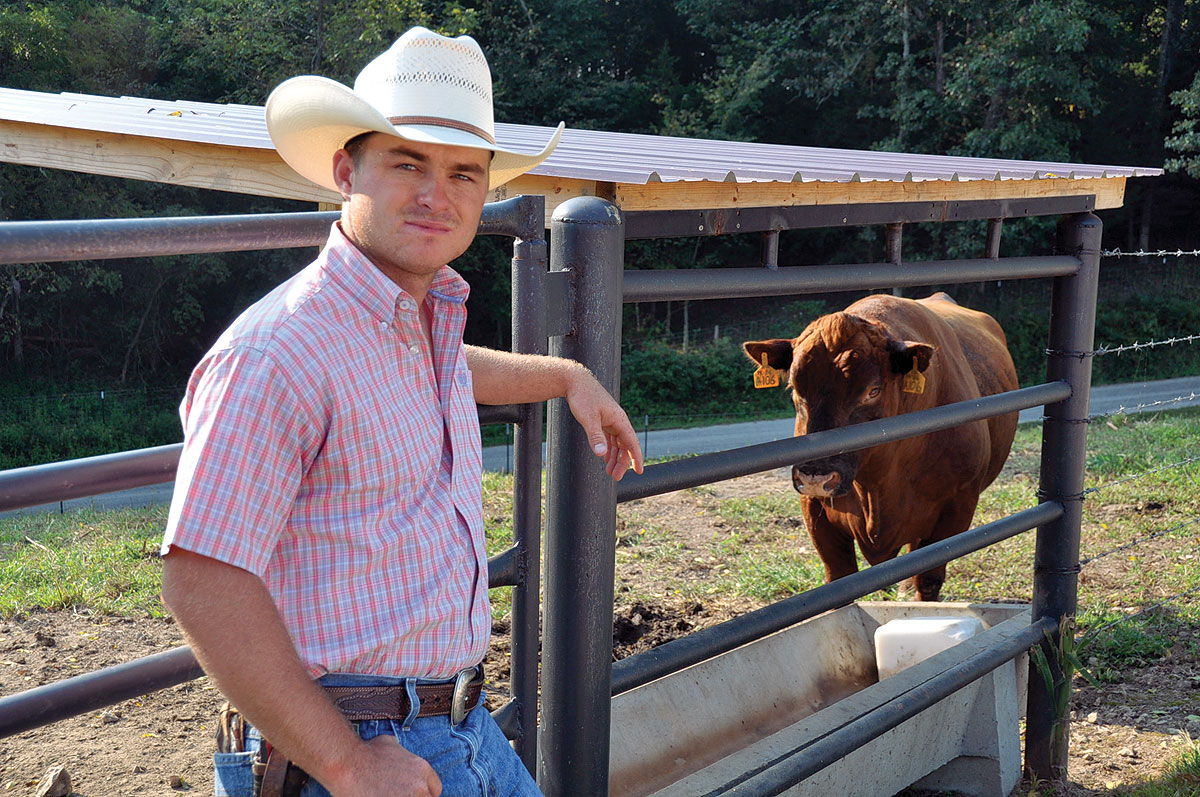
The Hills have been miking cows since 1978 on the family’s Century farm
LEBANON, MO. – Larry Hill grew up on the Laclede County, Mo., farm his grandparents, Thomas “Tuss” and Esther Hill, started in 1908.
The farm started with 80 acres, and over the years, Larry’s parents, Wallace and Freeda (Calton), added land to grow the operation.
“Every generation has added a parcel or two,” Larry said. “Back in the day, they did a little of this and a little of that here. Dad and Mom had hogs, beef, chickens and a small dairy. Big families back then had dairy cows they milked by hand, but Mom came from a working dairy in Morgan. When they got married, they remolded a barn and put in some stalls for a dairy.”
In the early 1970s, Wallace and Freeda sold their dairy cows and hogs, focusing instead on beef cattle and forages.
“We still always had a milk cow or two,” Larry added with a laugh.
Growing up, Larry said he liked to farm, but the dairy aspect did not appeal to him. He said it was too “slow.” His feelings about dairying, however, changed as he got a little older.
“I was in high school, had a car, and needed to buy gas,” Larry recalled. “I took a job milking for Hugh Corry. It was the first time I had ever been in a parlor. It was just a two-on-a-side walk-through, but it was a whole different thing from being in a stall. I thought, this really isn’t too bad.”
As he approached his senior year, Larry began exploring career options.
“At that time, in the late 1970s, if you were going to be a full-time farmer in this area, you were going to be a dairyman,” he said. “I thought about it, and I kind of liked milking in a parlor, so I started buying calves and raising heifers.”
In 1978, the year Larry graduated, the Hills built a barn. Wallace sold his beef cows and bought some dairy heifers to partner up with Larry, and Hill Dairy began.
Hill Dairy has about 130 cows, and Larry, his wife Maggie, and son Ryan all work on the farm.
Cows are primarily Holstein and Jersey. Holsteins are AI’ed to a Jersey, and Jerseys to a Holstein.
“The hybrid vigor on these cows makes them handy cows. It raises the butterfat, and you have nice, tight udders and great feet,” Maggie said.”
“We want to keep the Holstein/Jersey thing going,” Larry added. “We did throw in the Milking Shorthorn for a few years, but we found we got a big animal. We found we liked the smaller animals a little better. We don’t have the inputs, and they aren’t as crowded in the stalls.”
The herd average about 19,000 pounds, and the Jersey genetics helps boost the butterfat.
“We’re usually around 4 to 5 percent fat,” Larry said.

The Hill herd can have the comfort of a free stall barn, which was built in 1979, or graze the pastures of the farm.
Larry said cows are rarely confined to the barn.
“The only time would be in case of an ice storm, and they can’t get back. We used to really have winters,” he said. “We have timber, but cows can freeze teats coming back and forth, so we thought this isn’t going to cut it, so the free stall barn was built. Mostly, they come and go when they want, but they want to be in the barn when it’s hot. It’s good to get them off of the concrete every day and lay down where they have plenty of room. When it rains, they think they will melt and come running in.”
The Hills feel giving the animals a choice of lounging in the barn or grazing pastures makes the animal more productive and happier.
Only highly productive cows are bred to dairy bulls, with the remainder being bred to an Angus.
“We used to raise too many replacement heifers, and there’s no market for them to recoup the money we put into them,” Maggie said. “Ryan and Larry will breed for replacements about six months out of the year. The rest of the time, we run an Angus bull with the herd, and we sell those as babies.”
“We only need so many replacements, and not every replacement turns out to be a good animal,” Larry said. “Even when we AI, we keep some Angus semen because a cow might be at the low end of the group. It’s also nice to take a break where we can take a break and let the bull take care of it.”
Replacement heifers are bred at around 15 months of age but may be bred a little younger if they are large enough.
“We have a couple of big girls, so if they have the hip and the pelvic room, she might go in with an earlier group,” Maggie said, adding the heifers are bred to a Jersey bull for calving ease.
Forages fed at Hill Dairy are primarily grown on the farm and are mixed with purchased commodities.
“We feed a PMR (partial mixed ration) 365 days a year because we feed a little grain in the parlor just to get them in. Some people have gotten away from that, but we don’t like to drive them in,” Larry said. “For dairy cows, alfalfa is the number one thing, when whatever else you can throw in to stretch it. They don’t need straight alfalfa, but we raise and chop grasses to mix with it, and put it in silage bags to mix with it. We usually do some sorghum sudangrass to rotate the alfalfa out after a few years; it lasts a long time, but it gets to be unproductive. You can’t get the production without putting in some effort.”
Ryan is the fourth generation to be a part of the family operation, and his children – 17-year-old Allison, 15-year-old Landon and 8-year-old Raelyn – help out from time to time, but Larry has no plans for retirement.
“Hill men live until their 90s,” Maggie said. “Larry’s going to be around for at least 30 more years.”
For the Hills, there’s more to being a farmer than the land and the cattle; it’s about stewardship and being caretakers.
“We don’t own this land,” Maggie said. “We want to take good care of what God has given us; the animals, the equipment, and the land and do the best we can. Since we are followers of Jesus, it’s important that we glorify him in everything we do, in taking care of the animals and improving the land… He’s brought Ryan up the same way, and he’s following along.”







